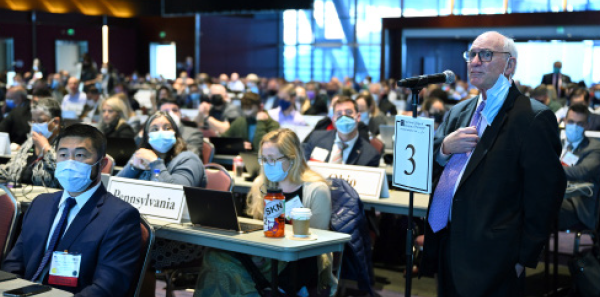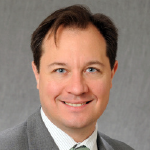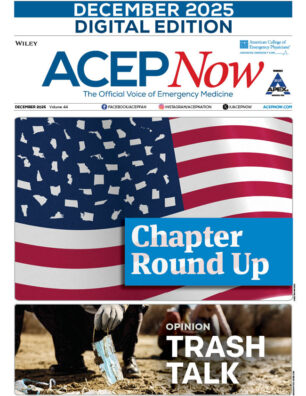
The ACEP Council, the College’s governing body, meets every year to discuss and vote on resolutions affecting emergency physicians.
Explore This Issue
ACEP Now: Vol 40 – No 12 – December 2021Any member can submit a resolution, but it must be in writing at least 90 days prior to the ACEP Scientific Assembly and be supported by at least one other ACEP member. If adopted, the resolutions become official ACEP policy.
This year at ACEP21 in Boston, the Council received a record 82 proposed resolutions. This was a big jump from only 58 resolutions considered in 2020 and 60 considered in 2019. Of the resolutions the Council considered this year, 56 were adopted, 15 were not adopted, 10 were referred to the Board of Directors, and one was referred to the Council Steering Committee.
Our editorial staff closely tracked a few of this year’s resolutions due to their interest and impact on emergency physicians.
Resolution 22: Expanding Diversity and Inclusion in Educational Programs

Hilary Fairbrother, MD, MPH, FACEP
Adopted by the Council, Resolution 22 requires ACEP to survey its speakers and educational presenters and report on their demographics. The resolution also calls for ACEP to set guidelines for its educational content to include material on diversity, inclusion, and health care disparities as well as to ensure panel members come from diverse backgrounds.
The New York Chapter submitted this resolution, which noted, “differences in care and diagnosis related to age, gender, identity, race, culture, sexual orientation, physical disability/limitation, ethnicity and social status are classically understudied and taught.”
The ACEP Education Committee has an ongoing objective to increase faculty diversity and to create programs that cover topics such as implicit bias and microaggressions in the setting of emergency medicine, according to background information prepared by Debbie Smithey, CMP, CAE, educational meetings director. In addition, the Educational Meetings Subcommittee has a strategy to increase diversity of speakers at ACEP meetings. Currently, ACEP members aren’t required to report their ethnicity data, and that creates difficulty for meeting organizers who look to the membership database for speakers, as they must then do additional research to identify the ethnicity of speakers, according to the notes in the proposed resolution.

Dara Kass, MD
Dara Kass, MD, associate clinical professor of emergency medicine at Columbia University Vagelos College of Physicians and Surgeons, was not involved in the resolution but supports the College’s effort to improve the diversity of its panelists. “Any time you deviate from the standard—which is historically white, male, able-bodied, and heterosexual—and decide you want to diversify, it takes effort,” she said.
Dr. Kass is the founder of FemInEM, an organization that seeks to support the advancement of women working in emergency medicine. The organization created a speakers bureau to help conference planners find expert speakers from underrepresented groups.
When organizing a meeting panel, the first step is to know who is speaking, which is not always apparent by name or surface-level demographic information, according to Dr. Kass. For its programs, FemInEM creates demographic spreadsheets and aims for its panels to represent a wide swath of the population.

Sudave D. Mendiratta, MD, FACEP
Dr. Kass encourages organizers to not only look for diversity in backgrounds but also diversity in thought. In 2018, for example, she organized a conference that included a lecture about reducing gun violence and recruited a politically conservative speaker who also owned guns. The other speakers did not meet this profile, and she wanted several different ideas to be presented.
Sometimes organizations need to provide financial support for inclusion goals. Dr. Kass feels it’s important to recruit speakers from underrepresented groups who might not have the resources or time off to travel to a meeting. “Collecting demographic data is one thing, but removing barriers, like paying for meeting travel, takes diversity and inclusion efforts to a higher level.”
Resolution 31: Employment-Retaliation, Whistleblower, Wrongful Termination
Resolution 31 is a response to accounts of emergency physicians being fired because of public comments they made about working conditions during the height of the COVID-19 pandemic. This resolution was submitted by Olga Gokova, MD, FACEP; Rebecca Parker, MD, FACEP; Amish Shah, MD, FACEP; and the Arizona College of Emergency Physicians.

William J. Naber, MD, JD
A few notable examples on this topic include Cleavon Gilman, MD, who was dismissed from his job at Yuma Regional Medical Center in Yuma, Arizona, because of tweets he sent in November 2020 about the surge of COVID-19 patients, according to the Arizona Republic. In one tweet, he said he was notified that all of the hospitals in Arizona were out of ICU beds.1
In March 2020, emergency physician Ming Lin, MD, was fired by PeaceHealth St. Joseph Medical Center in Bellingham, Washington, after he publicly described what he felt were unsafe practices by the hospital. He complained, for example, that patients were being screened for COVID-19 inside the hospital rather than outside, where there was less of a risk of the virus spreading, The Seattle Times reported.2
Legislators in Arizona reacted to Dr. Gilman’s case by introducing Arizona House Bill 2622.3 The bill prohibits retaliation against a health professional who reports a safety, harassment, or fraud concern to a health care institution and, “having provided the health care institution a reasonable opportunity to address the report, provides information to a private health care accreditation organization or governmental entity concerning the activity, policy or practice that was the subject of the report.” The bill also prohibits third-party contractors from taking retaliatory action against health care professionals who make such reports.
The ACEP Council adopted the resolution to submit a resolution to the June 2022 American Medical Association (AMA) House of Delegates Annual Meeting, “promoting the concepts of Arizona House Bill 2622 (2021).” The resolution also states the College will develop model legislation fashioned after the Arizona bill, which it will share with all ACEP chapters.
William J. Naber, MD, JD, associate professor of emergency medicine at the University of Cincinnati College of Medicine and associate chief medical officer at UC Health, said he likes that the Arizona bill basically asks health care professionals to first work within their institutions to address concerns.
“If I had a patient safety concern at my institution, we have so many avenues to work internally within the health care system to fix things,” he explained. “It would have to be a very significant event that goes unaddressed to turn externally [to the press or social media] to try to fix something.” Dr. Naber was not involved in the ACEP resolution or the Arizona bill.
He said that emergency physicians should receive whistleblower protection if they have exhausted all internal systems for addressing quality or safety concerns. After that, emergency physicians can turn to The Joint Commission or their state health department. Posting about the issue on social media should be a final resort, said Dr. Naber.
“You always you want a non-retaliatory feeling and culture of safe reporting at your institution; otherwise, people won’t report events if they are afraid of retaliation,” said Dr. Naber.
Resolution 47: Family and Medical Leave

Jesse Pines, MD, MBA, FACEP
The Council considered a resolution on family and medical leave and adopted it in part. The resolution was submitted by Megan Dougherty, MD, FACEP; Sarah Hoper, MD, JD, FACEP; the Iowa Chapter; the Vermont Chapter; and the American Association of Women Emergency Physicians Section.
The resolution called for ACEP to support the AMA’s effort to study the effects of Family Medical Leave Act expansion; conduct an environmental survey and create a paper on best practices regarding maternity, paternity, and family leave for emergency physicians; and issue a new statement in support of paid family leave. The first resolved was adopted, and the third was referred to the Board of Directors.
Resolution 47 notes that the United States is one of six United Nations member states that does not have a federal policy mandating paid maternity leave.4 ACEP’s current Family and Medical Leave statement, which was revised in 2019, does not specifically support paid family leave but encourages employers to “ take into consideration what can be done to support the individual financially” by offering at least 12 weeks’ leave for child birth or adoption, four weeks’ leave for a co-parent in child birth or adoption, and flexible work schedules for both parents before and after a new child.5
“I have friends who do not work in medicine, and when I told them you can be a doctor, work in a hospital, and not have paid maternity leave, they thought that was insane,” said Hilary Fairbrother, MD, MPH, FACEP, an emergency physician in Houston who was not involved in the Council resolution.
Dr. Fairbrother was six months pregnant when she accepted a new job in 2017. The three months she took off from work after delivery were mostly unpaid because she hadn’t accrued vacation or sick time that she could apply to her leave. Dr. Fairbrother also only partially qualified for short-term disability because her insurer considered her pregnancy to be a preexisting condition.
With her second child, Dr. Fairbrother was able to use accrued vacation and sick leave and apply for short-term disability, “which contributed to a different fiscal reality,” she explained. Dr. Fairbrother had established childcare to take care of her 2-month-old when she went back to work. She especially appreciated being able to do telemedicine and administrative work from home during the third month after giving birth, which helped her establish breastfeeding.
She said she supports a federal paid leave policy, but that employers should address the issue in the absence of a national policy. “In consulting, if you want diversity, if you want to attract and hire women, you need to offer paid maternity leave plus flexibility for when they transition back to work,” said Dr. Fairbrother. “We should advocate for the same standard in emergency medicine.”
Resolution 71: Emergency Medicine Workforce by Non-Physician Practitioners
The Council did not adopt Resolution 71, which was submitted by the Emergency Medicine Workforce Section. It called for ACEP to support the elimination of non-physician health care professionals in emergency departments except in cases where there aren’t enough emergency physicians to properly staff the facility.
The resolution notes the ACEP workforce study’s prediction that there will be an oversupply of board-certified emergency physicians by 2030.6 Nurse practitioners and physician assistants are currently supplying about 20 percent of emergency care across the United States, according to the study.
Workforce projections from the ACEP report are not reliable because they are based on extrapolated data from a few years ago, according to Jesse Pines, MD, MBA, FACEP, who is the national director of clinical innovation for the physician contracting company US Acute Care Solutions. They also do not include innovative models in emergency medicine beyond what was happening in brick-and-mortar emergency departments. “Telehealth, for example, is a growing field that needs more emergency medicine physicians,” said Dr. Pines, who is professor of emergency medicine at Drexel University College of Medicine and has conducted research on ED staffing.7
“What we can conclude from that report is there is probably not going to be an undersupply of emergency physicians [in the United States] by 2030. Much like today, there could continue to be an undersupply in rural areas and smaller emergency departments,” explained Dr. Pines.
Sudave D. Mendiratta, MD, FACEP, chair of emergency medicine at University of Tennessee College of Medicine, said current reimbursement models will ensure that advanced practice professionals are here to stay. “The question we should be asking is how we can ensure they have the appropriate scope of practice and support,” he explains.
Dr. Mendiratta, who is also the President of the Tennessee Chapter of ACEP, explained how emergency physicians, nurse practitioners, and physician assistants must collaborate in the face of nursing shortages.
Dr. Pines agreed. “A collaborative model, with oversight of advanced practice providers by emergency physicians, has been shown to deliver similar care than an emergency physician–only model.” The important things, he added, are that health care professionals follow clinical guidelines and that there are mechanisms to catch any clinical mistakes and to engage in continuous quality improvement.
Stephanie Cajigal is a medical journalist based in Los Angeles,
References
- Landers J. ‘A slap in the face’: Yuma hospital fires ER doctors for talking about COVID-19 in Arizona. Arizona Republic website. Accessed Nov. 29, 2021.
- Judd R. ER doctor who criticized Bellingham hospital’s coronavirus protections has been fired. The Seattle Times website. Accessed Nov. 29, 2021.
- HB 2622. An act amending section 36-450.02, Arizona Revised Statues; relating to health care institutions. State of Arizona House of Representatives website. Accessed Nov. 29, 2021.
- Maternity leave benefits. United Nations Statistics Division website. Accessed Nov. 29, 2021.
- Family and medical leave. ACEP website. Accessed Nov. 29, 2021.
- Marco CA, Courtney DM, Ling LJ, et al. The emergency medicine physician workforce: projections for 2030. Ann Emerg Med. 2001;78(6):726-737.
- Pines JM, Zocchi MS, Ritsema T, et al. The impact of advanced practice provider staffing on emergency department care: productivity, flow, safety, and experience. Acad Emerg Med 2020;27(11):1089-1099.
Pages: 1 2 3 4 | Multi-Page





No Responses to “ACEP Council Resolutions Tackle Key Issues”